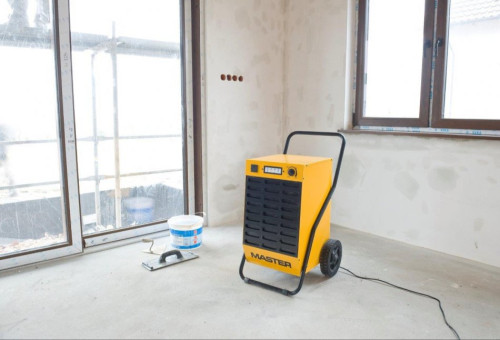How to choose the optimum dehumidifier?
Dehumidifiers come in handy wherever there is excess moisture accumulated in walls, ceilings or floors. If ventilation cannot cope with its removal or the process takes too long, a dehumidifier should be used. This is extremely important, as excessive dampness can have very negative consequences - both for the rooms themselves and for the equipment in them, as well as for people's health.

Dehumidifiers come in handy wherever there is excess moisture accumulated in walls, ceilings or floors. If ventilation cannot cope with its removal or the process takes too long, a dehumidifier should be used. This is extremely important, as excessive dampness can have very negative consequences - both for the rooms themselves and for the equipment in them, as well as for people's health.
The correct room humidity should be between 40-60% at a temperature of around 20°C. Too low or too high a water vapour content in the air is unfavourable for people working in the rooms. Excess moisture leads to accelerated corrosion and impairs the operation of machinery and equipment. Conditions for fungal growth are created in damp walls and ceilings. Therefore, the persistence of dampness over a prolonged period should be avoided at all costs. To accomplish this task, it is best to hire a dehumidifier to effectively get rid of the dampness.
Where are dehumidifiers used?
Depending on their performance, dehumidifiers are used in many situations where rooms become very damp. The most common application of these devices is in drying newly constructed buildings and rooms after major renovations. Bricklaying, plastering, painting or pouring floors - these are common situations in which moisture accumulates in walls and it is worth using a dehumidifier.
A second typical group of applications for dehumidifiers is restoring flooded rooms due to installation failures or flooding during floods or heavy rainfall.
If, after using a dehumidifier, the air humidity quickly returns to a very high level, it can be assumed that the humidity is the result of a malfunctioning ventilation system or permanent penetration of water into the walls, as is often the case in the basements of old buildings whose foundations lack damp-proofing.
What to look for when choosing a dehumidifier?
When hiring a dehumidifier, it is important to pay attention to a few essential features of the device:
- performance - this is a parameter measured in the number of litres of water recovered from the air per day - manufacturers usually state to which temperature and humidity the performance indicator relates: it should be related to the specific situation in the room being dehumidified,
- airflow - indicates the number of cubic metres of air that flows through the dehumidifier in one hour - the higher the airflow, the higher the efficiency of the unit,
- water tank capacity - once the tank is full, the dehumidifier automatically switches off, so the capacity should be carefully selected according to the humidity and size of the room to be dehumidified, or provide drainage to a larger tank or straight to the sewer,
- energy consumption - given that a dehumidifier is an appliance that often runs continuously for weeks at a time, it is worth checking the nominal energy consumption quoted by the manufacturer.
The performance parameters listed depend very much on the type of dehumidifier, i.e. what type of dehumidifier you are using - condensing or adsorption.
Would a condensation or adsorption dehumidifier be better?
Condensing and adsorption dehumidifiers differ fundamentally in the way they operate. Condensing units use evaporators and condensers, whose function is to adequately cool (below the dew point) the humid air and condense the water vapour. In contrast, adsorption dryers are equipped with an absorber (rotor), which removes moisture from the air and is then regenerated with hot air.
The different technologies have a direct impact on the performance of dehumidifiers under certain environmental conditions. In the case of adsorption dehumidifiers, performance remains constant regardless of the ambient temperature. Adsorption dehumidifiers operate effectively even at negative temperatures, which allows them to be used in unheated rooms. Condensation units, on the other hand, operate most efficiently in positive temperatures, above 20°C and at humidity levels above 60%. As regards resistance to air pollution, adsorption units are more susceptible to the negative effects of pollutants for obvious reasons (presence of a rotor).
If we are not sure what type and model of dehumidifier will be optimal, we can seek advice from a specialist from an equipment rental company. Simply describe the conditions in which we intend to use the unit to get the equipment that best suits our needs.